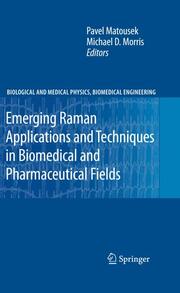Detailansicht
Emerging Raman Applications and Techniques in Biomedical and Pharmaceutical Fields
Biological and Medical Physics, Biomedical Engineering
ISBN/EAN: 9783642026485
Umbreit-Nr.: 1663787
Sprache:
Englisch
Umfang: xii, 478 S., 293 s/w Illustr., 26 farbige Illustr.
Format in cm: 3.6 x 24.1 x 16.5
Einband:
gebundenes Buch
Erschienen am 12.02.2010
Auflage: 1/2010
- Zusatztext
- The book presents the latest technological advances in Raman spectroscopy that are presently redrawing the landscape of many fields of biomedical and pharmaceutical R&D. Numerous examples are given to illustrate the application of the new methods and compared with established and related techniques. The book is suitable for both new researchers and practitioners in this area as well as for those familiar with the Raman technique but seeking to keep abreast of the latest dramatic advances in this field.
- Kurztext
- Inhaltsangabe1. Lasers, spectrographs and detectors.- 2. Fiber optic Raman probes for biomedical and pharmaceutical applications.- 3. Deep layer tissue and powder spectroscopy: SORS and transmission Raman.- 4. SERS and its applications to biological samples.- 5. Raman, mapping, imaging and tomography.- 6. Coherent Raman scattering microscopy.- 7. Raman optical activity (ROA).- 8. Chemometrics.- 9. Discovery and formulation.- 10. Raman spectroscopy: a strategic tool in the process analytical technology toolbox.- 11. Emerging dental applications of Raman spectroscopy.- 12. Raman spectroscopy of ocular tissues.- 13. Raman spectroscopy for early cancer detection, diagnosis and elucidation of disease specific biochemical changes.- 14. Raman spectroscopy of bone and cartilage.- 15. Vibrational microscopic imaging of skin: applications to drug delivery, single cell biochemistry and wound healing.- 16. Raman spectroscopy of blood and urine specimens.- 17. Quantitative Raman and fluorescence spectroscopy of artificial hip prostheses.- 18. Raman spectroscopy: a tool for tissue engineering.- 19. Biomedical and pharmaceutical applications of Raman spectroscopy.- 20. Future directions.
- Autorenportrait
- Michael D. Morris is professor of chemistry at the University of Michigan and an affiliated member of the university's Biomedical Engineering faculty, its Comprehensive Cancer Center and its Core Center for Musculoskeletal Research. He presently serves on the editorial boards of Applied Spectroscopy, Journal of Biomedical Optics and Calcified Tissue International. His honors include the ACS Division of Analytical Chemistry Award in Spectrochemical Analysis, the Anachem Award, the Society for Applied Spectroscopy New York Section Gold Medal and Meggers Award, the Mann Award in Applied Raman Spectroscopy, and several University of Michigan awards. His research interests include Raman spectroscopy and Raman imaging. He is a pioneer in the analytical applications of Raman spectroscopy, particularly in its uses in microscopy and imaging. He has made important contributions to Raman spectroscopic instrumentation based on holographic and liquid crystal optics and has been a leader in development of computational techniques for multivariate Raman image processing and three-dimensional Raman imaging. In the last several years his laboratory has led the development of Raman spectroscopy for study of musculoskeletal tissues. He and his co-workers have published on bone biomechanics, structure/function relationships in mouse models for genetic disorders, mechanisms of tissue mineralization and non-invasive spectroscopic assessment of bone quality. Pavel Matousek obtained his MSc and PhD degrees in physics from the Czech Technical University, Prague, the Czech Republic, the latter in partnership with the Rutherford Appleton Laboratory (RAL) in the UK. From 1991, he has worked at the Central Laser Facility, RAL where he is presently a Programme Manager at the Lasers for Science Facility. His research includes the use of time-resolved Raman spectroscopy in the investigation of short lived intermediates, the rejection of fluorescence from Raman spectra and the application of nonlinear optics in spectroscopy and high power laser research. His current research focuses on the development of deep non-invasive Raman methods for biomedical, pharmaceutical and security applications. He is a co-recipient of two Meggers Awards from the Society of Applied Spectroscopy. In 2007, he was appointed as a Fellow of the Science and Technology Facilities Council and as a Visiting Professor of the University College London. He is also serving as an International Delegate on the Governing Board of the Applied Spectroscopy (2007-2009).
